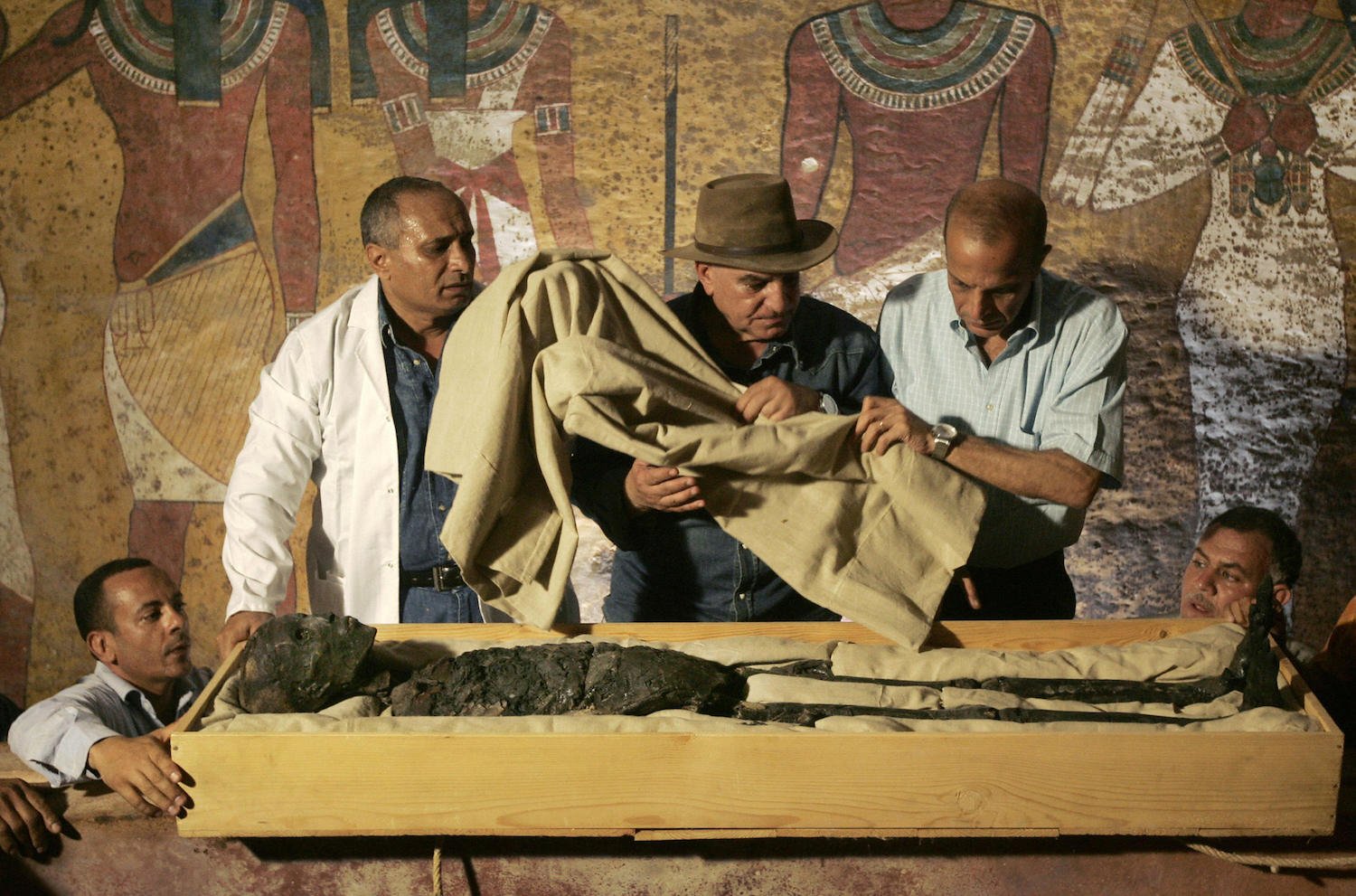
King Tut is hitting the road. As the 100th anniversary of the discovery of the tomb of Tutankhamun approaches, artifacts from the legendary site are heading on a 10-city international tour. The boy king’s final resting place, undisturbed and completely intact, was discovered by English archaeologist Howard Carter on November 4, 1922, its golden treasures igniting the imaginations of people around the world.
The coming exhibition, a guaranteed blockbuster titled “King Tut: Treasures of the Golden Pharaoh,” will debut at the California Science Center in Los Angeles on March 24, 2018. The unprecedented event, featuring golden jewelry, sculptures, and ritual objects, is being billed by the science center as a “once-in-a-lifetime exhibition.”
Removal of the gilt shrine from the Tomb of Tutankhamun, Valley of the Kings, Egypt, 1922–23. Photo by Harry Burton, courtesy of Heritage Image Partnership Ltd./Alamy Stock Photo.
It will feature 150 original objects from the famed tomb, the largest collection of King Tut artifacts ever to be exhibited internationally. By comparison, the famed “Treasures of Tutankhamun” exhibition that visited seven American cities between 1976 and 1979, setting off a second round of Egyptomania, featured only 55 pieces. (It was part of an international tour that ran from 1972 to 1981.)
For this outing, 60 of the works included will be leaving Egypt for the first time. “See them, visit them, before they return back to Egypt forever,” said Mostafa Waziry, secretary general of Egypt’s Ministry of State for Antiquities, in a video announcing the touring show.
“Each object is unique,” added archaeologist Zahi Hawass, Egypt’s former antiquities chief, calling the show “a monumental achievement for the preservation of ancient Egyptian history and King Tutankhamun’s place in it.”
In additional to showcasing historic pieces such as a life-size wooden guardian of Ka statue and a ceremonial funerary bed, the exhibition “will go deeper. It will go into the science, and help people understand how our knowledge and our understanding of science has allowed us to learn more about these objects,” said California Science Center president Jeff Rudolph. This includes DNA testing on King Tut’s mummy and the ongoing conservation work that continues to preserve this important part of our world heritage.
The restorer Ahued El Sheikka carries out a complete restoration of two shields from the tomb of Tutankhamen. Photo courtesy of Philippe Bourseiller/Getty Images Reportage.
Throughout its travels, the exhibition is sure to bring with it a major boost to local tourism. When the touring show “Tutankhamun and the Golden Age of the Pharaohs” touched down in the US at the Los Angeles County Museum of art in 2005, it attracted almost a million visitors, generating $168 million in tourism for the city.
According to the Los Angeles Times, organizers are expecting visitors to the upcoming show to spend $109 million–272 million. Emsi, an economic analysis firm, estimates that 1,045 jobs will be created.
For Egypt’s part, the country will put proceeds from the exhibition toward the construction of Cairo’s Grand Egyptian Museum, a project that has faced financial struggles. In the works since 2002, the long-delayed museum is scheduled to partially open in May 2018.
Howard Carter and an Egyptian workman examine the third coffin of Tutankhamun made of solid gold, inside the case of the second coffin (October 1925). Photo by Harry Burton, courtesy of INTERFOTO/Alamy Stock Photo.
Other recent setbacks to the country’s antiquities programs have included a botched restoration of King Tut’s famed funerary mask. The priceless artifact was restored, but the Egyptian Museum held a disciplinary hearing over the matter. A successful tour would help set to rest concerns that Egypt is ill-equipped to care for its archaeological heritage.
King Tut ruled from about 1332 to 1323 BC. Using 3-D technology, researchers recently revealed what the boy king would have looked like, while new research suggests that his tomb contains a sealed-off chamber, possibly containing an older tomb for Queen Nefertiti.
See more artifacts from the exhibition below.
Wishing cup in the form of an open lotus from the tomb of Tutankhamun. ©Laboratoriorosso, Viterbo/Italy.
Gilded wooden jackal-headed figure of Duamutef from the tomb of Tutankhamun. ©Laboratoriorosso, Viterbo/Italy.
Shrine made of wood covered with gold foil inside and gold leaf outside, from the tomb of Tutankhamun. ©Laboratoriorosso, Viterbo/Italy.
“King Tut: Treasures of the Golden Pharaoh,” will be on view at the California Science Center, Los Angeles, 700 Exposition Park Drive, March 24, 2018–January 2019. It will then travel to Europe as part of its 10-city tour.